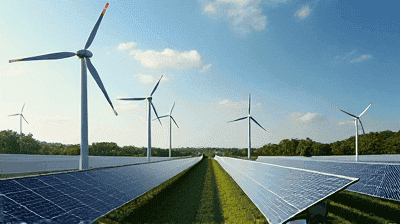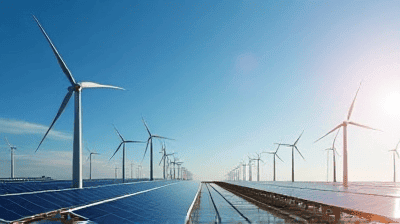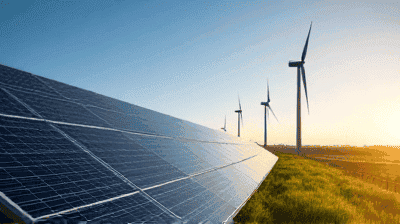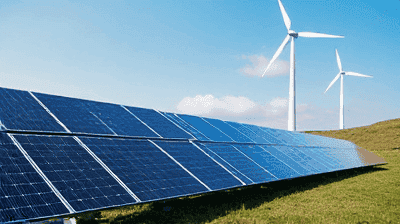
As the world confronts the devastating impacts of climate change, the transition from fossil fuels to renewable energy sources has become more urgent than ever. Among the various renewable energy options available, solar and wind energy stand out as two of the most promising solutions for large-scale power generation. With their potential to reduce greenhouse gas emissions and foster a sustainable energy future, both solar and wind energy technologies are rapidly gaining traction. However, a key question arises: which of these two renewable energy sources is more efficient for large-scale power generation?
Before diving into the specifics of solar and wind energy, it is important to understand what energy efficiency means in this context. Energy efficiency refers to the ability of a technology to convert potential energy (from the sun or wind) into usable electrical energy. The efficiency of renewable energy systems can be defined through various parameters, including:
By considering these factors, we can evaluate how solar and wind energy perform in large-scale power generation.

Solar energy harnesses the sun's radiation through photovoltaic (PV) cells or solar thermal systems. The most common technology for large-scale power generation is utility-scale solar photovoltaic systems.
Photovoltaic (PV) Systems: These systems convert sunlight directly into electricity using semiconductor materials like silicon. PV panels can be deployed in various configurations, from ground-mounted solar farms to rooftop installations.
Concentrated Solar Power (CSP): CSP technology uses mirrors or lenses to focus sunlight onto a small area to generate heat, which is then used to produce electricity through steam turbines. While CSP is less common than PV, it is effective in areas with high direct sunlight.
The efficiency of solar PV panels typically ranges from 15 to 22 percent for commercially available models. Advances in technology have led to the development of high-efficiency panels achieving efficiencies above 23 percent in laboratory settings. CSP systems can have similar or higher efficiencies, especially when energy storage is integrated into the design.
The capacity factor for solar installations varies significantly based on location, weather conditions, and seasonal fluctuations. On average, utility-scale solar projects have a capacity factor ranging from 15 to 25 percent. In regions with high solar irradiation, such as the southwestern United States, capacity factors can exceed 30 percent.
Land use efficiency for solar energy is a crucial consideration, particularly for large-scale installations. Solar farms require significant land areas, with estimates suggesting around 2 to 5 acres per megawatt (MW) of capacity. Dual-use strategies, such as agrivoltaics, which combine agriculture and solar energy production, can enhance land use efficiency.
Wind energy captures kinetic energy from wind through turbines, converting it into electricity. Wind farms can be located onshore (land-based) or offshore (in bodies of water).
Modern wind turbines can achieve conversion efficiencies of 40 to 50 percent, with some machines reaching efficiencies over 60 percent in optimal conditions. The effectiveness of a wind turbine is often characterized by its capacity factor.
The capacity factor for wind energy varies based on location, wind conditions, and turbine technology. Onshore wind farms typically have a capacity factor between 25 and 40 percent, while offshore wind farms benefit from stronger and more constant winds, leading to capacity factors that can exceed 50 percent.
Wind energy has a relatively high land use efficiency, as turbines can be spaced apart, allowing for agricultural activities to continue below them. Estimates suggest that wind farms can generate about 1 MW of energy per acre.

When comparing efficiency, both solar and wind energy have unique attributes. Solar panels may have lower capacity factors in certain regions compared to wind turbines, but they offer space-saving advantages, especially in urban settings.
To achieve optimal efficiency and reliability, many regions will benefit from an integrated approach that combines both solar and wind energy, leveraging their respective strengths and complementing each other’s weaknesses. This hybrid model can foster a more resilient and sustainable energy grid.
The effectiveness of solar versus wind energy is highly dependent on regional factors:
Effective energy storage technologies are essential for addressing the intermittency challenges of both solar and wind energy. Here are some key points regarding this intersection:
Battery Storage: Advances in lithium-ion and other battery technologies allow for effective energy storage to balance supply and demand. These systems can store excess energy generated during peak production periods for use during low production times.
Pumped Hydro Storage: This traditional method utilizes excess energy to pump water to high elevations, releasing it to generate power when needed.
Grid Management Technologies: Smart grid technology allows for real-time management of renewable energy inputs, helping balance supply and demand and integrating diverse sources into the grid.
As regions transition to renewables, natural gas can serve as a bridge fuel in the energy mix. Natural gas facilities can ramp up quickly to provide power when solar and wind generation is low, aiding in grid stability while reducing reliance on coal and oil.

Government policies and incentives play a vital role in the success of both solar and wind energy industries:
Subsidies and Tax Incentives: Many countries provide financial incentives to encourage renewable energy development, including investment tax credits for solar projects and production tax credits for wind farms.
Renewable Portfolio Standards: Mandates that require utilities to source a certain percentage of their energy from renewable sources are effective in driving adoption and market growth.
Funding for Research and Development: Continued investment in research and development can facilitate advances in solar and wind technologies, making them more competitive and efficient.
The cost of solar and wind energy has seen a dramatic decline over recent years. The levelized cost of electricity (LCOE) for both solar and wind has dropped significantly, making them more competitive with traditional energy sources. Factors influencing market dynamics include:
Technology Advancements: Improvements in manufacturing processes, materials, and energy efficiency are driving down costs for both technologies.
Energy Demand: The growing global demand for clean energy, driven by climate commitments and consumer preference, is catalyzing further investment in renewables.
Global Supply Chains: Global supply chains for solar panels and wind turbines can impact pricing, availability, and local job creation.
Both solar and wind energy present compelling options for large-scale power generation in the quest for a sustainable energy future. While wind energy generally exhibits higher conversion efficiency and capacity factors, solar energy offers a versatile resource that can be deployed across a broader range of environments and applications.
Ultimately, the most efficient approach may not be to choose one over the other, but rather to leverage the strengths of both technologies in tandem. By developing an integrated renewable energy strategy that utilizes the complementary benefits of solar and wind, societies can create a more resilient, reliable, and sustainable energy grid.
As the world continues to confront the climate crisis, the transition to renewables should be a priority, and understanding the nuances of solar and wind energy will be essential for policymakers, businesses, and individuals alike.